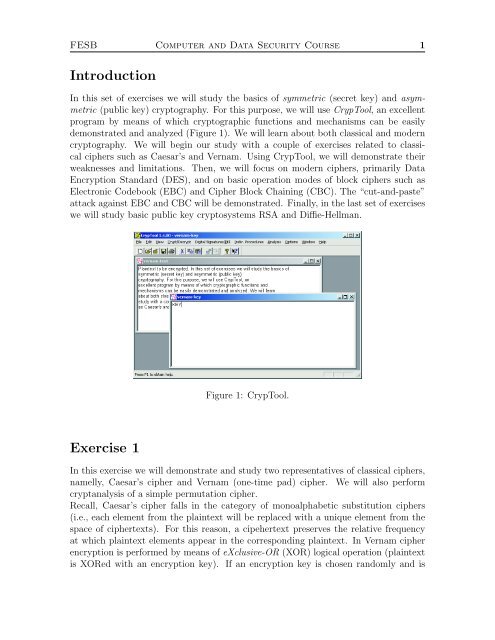Laboratory Exercises II: Symmetric and Asymmetric Cryptography
Laboratory Exercises II: Symmetric and Asymmetric Cryptography
Laboratory Exercises II: Symmetric and Asymmetric Cryptography
You also want an ePaper? Increase the reach of your titles
YUMPU automatically turns print PDFs into web optimized ePapers that Google loves.
FESB Computer <strong>and</strong> Data Security Course 1<br />
Introduction<br />
In this set of exercises we will study the basics of symmetric (secret key) <strong>and</strong> asymmetric<br />
(public key) cryptography. For this purpose, we will use CrypTool, an excellent<br />
program by means of which cryptographic functions <strong>and</strong> mechanisms can be easily<br />
demonstrated <strong>and</strong> analyzed (Figure 1). We will learn about both classical <strong>and</strong> modern<br />
cryptography. We will begin our study with a couple of exercises related to classical<br />
ciphers such as Caesar’s <strong>and</strong> Vernam. Using CrypTool, we will demonstrate their<br />
weaknesses <strong>and</strong> limitations. Then, we will focus on modern ciphers, primarily Data<br />
Encryption St<strong>and</strong>ard (DES), <strong>and</strong> on basic operation modes of block ciphers such as<br />
Electronic Codebook (EBC) <strong>and</strong> Cipher Block Chaining (CBC). The “cut-<strong>and</strong>-paste”<br />
attack against EBC <strong>and</strong> CBC will be demonstrated. Finally, in the last set of exercises<br />
we will study basic public key cryptosystems RSA <strong>and</strong> Diffie-Hellman.<br />
Exercise 1<br />
Figure 1: CrypTool.<br />
In this exercise we will demonstrate <strong>and</strong> study two representatives of classical ciphers,<br />
namelly, Caesar’s cipher <strong>and</strong> Vernam (one-time pad) cipher. We will also perform<br />
cryptanalysis of a simple permutation cipher.<br />
Recall, Caesar’s cipher falls in the category of monoalphabetic substitution ciphers<br />
(i.e., each element from the plaintext will be replaced with a unique element from the<br />
space of ciphertexts). For this reason, a cipehertext preserves the relative frequency<br />
at which plaintext elements appear in the corresponding plaintext. In Vernam cipher<br />
encryption is performed by means of eXclusive-OR (XOR) logical operation (plaintext<br />
is XORed with an encryption key). If an encryption key is chosen r<strong>and</strong>omly <strong>and</strong> is

















